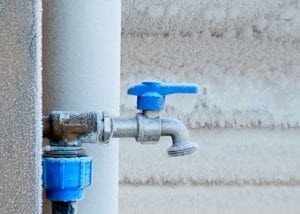Winterize Outdoor Faucets and Avoid Problems With Frozen Pipes
With the winter weather comes potential home issues none of us would like to face. Now’s the time to learn how to winterize outdoor faucets; not the afternoon before the first hard freeze of the winter.
Down to about 28 degrees, there’s generally enough latent heat in the water inside pipes to resist freezing. Below that mark, ice can begin to form inside supply lines, including those that feed outdoor faucets. Freezing at an outdoor faucet may actually cause a rupture upstream in the water line indoors, releasing hundreds of gallons of water into your walls or flooding the basement. Knowing how to winterize outdoor faucets can not only protect your outdoor fixtures but also your home’s interior.
How to Winterize Outdoor Faucets
- Store garden hoses – Remove garden hoses connected to faucets and drain them of residual water. Store hoses in a dry area until the spring.
- Find the shut-off valves – Determine the location of all outdoor faucets and locate the corresponding indoor shut-off valves for each. They will typically be located near the ceiling of the basement close to where the supply line leads outdoors to the faucet. In newer homes, faucet shut-off valves may be located immediately next to the main water shutoff and are clearly labeled. In most cases, they’re lever-style valves instead of rotating knobs.
- Drain the lines – When a hard freeze threatens, turn off the water to each faucet at its individual shut-off valve, then go outside and open the faucet. Return to the shut-off valve indoors and hold a bucket under it as you unscrew the small bleeder cap incorporated into the faucet. Residual water will drain out of the line into the bucket. Once the line is drained, replace the bleeder cap and go outside and close the faucet.
Alternatives
If your home isn’t fitted with faucet shut-off valves, you have two options. A professional plumber can retrofit special “frost free” faucets with long stems that position the valve inside the conditioned zone of the home instead of outdoors. Alternatively, faucet insulation kits commercially available at hardware and home centers can be installed for temporary protection.
For information on professional plumbing services including steps to winterize outdoor faucets, contact Custom Mechanical.
Image Provided by Shutterstock.com


